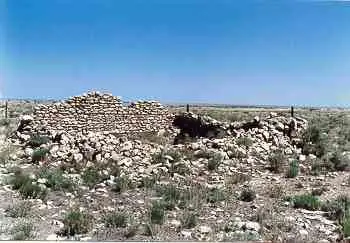CANYON DIABLO
|
CANYON DIABLO |
|
|
|
|
NAME: Canyon
Diablo COUNTY: Coconino ROADS: 4WD LEGAL INFO: T21N, R12E CLIMATE: Cold winter; Hot summer BEST TIME TO VISIT: Winter, fall |
COMMENTS:
Located off I-40 across from the old Route
66 stop of Two Guns. Within the Navajo reservation. Update: The Navajo Reservation,
where the ruins are located, is planning to rebuild this town as a tourist
attraction. REMAINS: One large stone building and part of another. |
|
Not well known, but Canyon Diablo is suppose to have been even wilder and more wicked than Tombstone. This originated as a railroad town in 1880 that sprang up where construction of the railroad had halted until a bridge could be built over the canyon. There was a delay due to finances. It was not until 1890 that the rail bridge was completed. No law existed here since the nearest law enforcement was over 100 miles away and the robbers and cutthroats had their way. It is said that any drifters either moved on or ended up in the cemetary. The saloons, gambling houses and brothels ran 24 hours a day never closing. Once the railroad bridge was built over the canyon, the town soon died. Submitted by Tom McCurnin. I recently read through "Two Guns, Arizona" by Gladwell Richardson (1968), and found that there was quite a bit of information on the original town of Canyon Diablo... I thought it may prove interesting for the page if you cared to use it. The pictures on the site are the ruins of a trading post, from after the original town had disappeared. The one of mine is a cistern north of the trading post. >From the book: "It was a shack town. Two lines of buildings faced each other across the rocky road on the north line of the right-of-way. They extended east one mile from the yellow-painted depot. It was the railhead for Flagstaff, Prescott, and other towns west and south...a regular stage line also operated between Flagstaff and Canyon Diablo."Along Hell Street stood fourteen saloons, ten gambling dens (or poker flats), four houses of ill-repute and two dance pavilions which were hardly more than houses of ill-repute themselves. None of the shacks were substantial buildings, being green lumber frames covered with tin, tar paper, and canvas. Wedged between these places were eating counters, and a grocery and dry goods store. Few had a name lettered on their drab, unpainted false fronts."The houses of prostitution were untitled. The favorites were owned by Clabberfoot Annie and B.S. Mary (the initials stand for what you think they do)...their competetive places faced each other across the dusty, stony road..." The book goes on to describe the boothill cemetery where 35 graves could once be seen - the wooden markers & fences now gone, and the few that were covered with stone now indiscernible. The only grave left is of Herman Wolf, a trader who passed away in 1899 - and the only person buried there to have died peacefully. The majority of the graves (unmarked & mass) could be found north and south of the tracks, as well as along the eastern edge of the canyon. Of the six peace officers that existed there, not one of them lived longer than a month in the position; the first put on his badge at 3 pm, was laid out for burial at 8 pm. The army was eventually requested to take over law enforcement, but before they arrived, the bridge was completed and the town dried up. Essentially, there is nothing left of the old town of 2,000 people - which was bigger than Flagstaff at the time - and today, only the trading post, the grave of Herman Wolf, and the spot which I believe is the Canyon Diablo station can be seen. . Joe Grumbo
|
 Canyon Diablo Courtesy Tom McCurnin
|
|
|